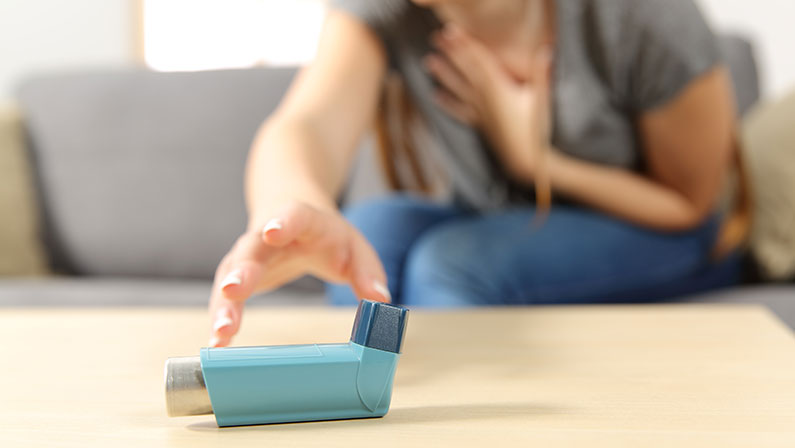Amid an asthma attack, the absence of an inhaler can be alarming.
However, there are alternative methods to ease symptoms and regain control.
Explore proactive strategies and natural remedies to relieve asthma without relying on the familiar inhaler crutch in this guide.
What Is An Asthma Attack?
An asthma attack is a sudden and severe worsening of asthma symptoms. It is characterized by the inflammation of the airways and increased mucus production, making breathing difficult.
During an attack, the muscles around the airways may tighten, further restricting airflow. The triggers for asthma attacks can vary, ranging from exposure to allergens and irritants to stress and physical exertion.
Symptoms Of An Asthma Attack
Experiencing an asthma attack can be frightening, as the symptoms manifest rapidly. The first indicator is shortness of breath, accompanied by a persistent cough, wheezing, and chest tightness.
During an attack, individuals may also notice:
- Increased Respiratory Rate: The breathing becomes rapid and shallow.
- Difficulty Speaking in Full Sentences: Communicating becomes challenging due to limited airflow.
- Wheezing: A high-pitched whistling sound during breathing.
- Persistent Cough: A cough that persists and worsens, especially at night.
Causes Of Asthma

Asthma involves genetic and environmental factors. Recognizing its triggers is critical to effective management.
- Genetic Predisposition: Individuals with a family history of asthma are at a higher risk, as certain genetic factors can contribute to susceptibility.
- Environmental Allergens: Exposure to common allergens such as pollen, pet dander, mold, and dust mites can trigger asthma symptoms.
- Occupational Exposures: Certain workplace environments with airborne irritants or allergens, like chemicals or dust, may contribute to the development or exacerbation of asthma.
- Respiratory Infections: Viral infections, particularly during early childhood, can increase the likelihood of developing asthma, affecting the respiratory system’s development and function.
Asthma Attack Treatment
Effectively managing an asthma attack requires a comprehensive approach, with various treatment options available. Each treatment method is crucial in providing relief and restoring normal respiratory function.
Use of an Inhaler
An inhaler, commonly known as a rescue or bronchodilator inhaler, is a swift and effective way to alleviate acute asthma symptoms. This over-the-counter medication for asthma helps relax and widen the airways, providing quick relief during an attack.
You need to understand the proper inhaler technique for optimal efficacy, and individuals should be well-versed in its use to ensure prompt and accurate administration.
Corticosteroid Medications
Corticosteroids, whether inhaled or taken orally, are often prescribed for long-term asthma management. During an asthma attack, systemic corticosteroids may be administered to reduce airway inflammation and prevent a further escalation of symptoms.
Inhaled corticosteroids are also commonly used as maintenance therapy to control and prevent chronic symptoms.
Oxygen Therapy
In severe asthma attacks, oxygen levels in the blood may drop significantly, oxygen therapy becomes a critical intervention. Administered through a mask or nasal prongs, supplemental oxygen helps ensure the body receives adequate oxygen levels, supporting respiratory function during an acute episode.
Oxygen therapy is often utilized in a hospital setting under medical supervision. Thus, it is important to seek professional medical attention during severe asthma attacks.
How Do You Control an Asthma Attack Without an Inhaler?

Managing an asthma attack without an inhaler requires a calm and strategic approach. By implementing specific techniques, individuals can mitigate symptoms and improve their respiratory well-being even when an inhaler is not immediately available.
Sit Upright
Assume an upright position to optimize airflow and reduce the pressure on your chest. Sitting upright helps ease breathing difficulties during an asthma attack, promoting better oxygen intake.
Slow Down Your Breathing by Taking Long, Deep Breaths
Consciously slowing down your breathing and taking deep breaths can help relax the airways and prevent further constriction. Focus on extending both the inhalation and exhalation phases to encourage a more controlled respiratory rhythm.
Stay Calm
Anxiety and stress can exacerbate symptoms. Prioritize calmness during these times. Stay composed and know the relaxation techniques, such as mindfulness and controlled breathing.
Get Away From the Trigger
Identify and remove yourself from any potential triggers that may have caused or worsened the asthma attack. Distancing yourself from the source can aid in symptom relief, whether it’s allergens, smoke, or other irritants.
Drink a Hot, Caffeinated Beverage
Hot, caffeinated beverages like tea or coffee can act as mild bronchodilators, helping open airways. The warmth can also provide a soothing effect, contributing to respiratory comfort.
Get Medical Help
While these strategies offer temporary relief, seeking prompt medical assistance is crucial. If an inhaler is unavailable or symptoms persist, contact emergency services or head to the nearest healthcare facility for professional intervention and guidance.
How Are Asthma Attacks Prevented?
Preventing asthma attacks involves a proactive approach to managing triggers and maintaining respiratory health. By adopting effective strategies, individuals can significantly reduce the risk of experiencing debilitating asthma episodes.
- Identify and Avoid Triggers: Recognize specific allergens or irritants that trigger asthma symptoms and take steps to minimize exposure. This may include using air purifiers, keeping living spaces clean, and avoiding tobacco smoke.
- Adherence to Medication: Consistent use of prescribed medications, such as controller inhalers or oral medications, as directed by a healthcare professional, helps control inflammation and prevent asthma exacerbations. Following a defined treatment plan is essential for long-term management.
- Regular Monitoring and Check-ups: Regular check-ups with a healthcare provider help monitor asthma control and adjust treatment plans as needed. Asthma management should be a collaborative effort between the individual and the healthcare team to optimize preventive measures.
Complications Of An Asthma Attack
While asthma attacks can often be managed with prompt intervention, complications may arise, emphasizing the importance of preventive measures to minimize the risk of severe outcomes.
- Respiratory Failure: In severe cases, asthma attacks can lead to respiratory failure, where the lungs cannot provide adequate oxygen to the body. This can be life-threatening and requires immediate medical attention.
- Pneumonia: The risk of developing pneumonia increases after an asthma attack due to compromised lung function. Inflammation and mucus buildup can create an environment conducive to respiratory infections.
- Chronic Obstructive Pulmonary Disease (COPD): Long-term, uncontrolled asthma can contribute to the development of COPD, a progressive lung disease that significantly impairs airflow.
Asthma Attack Not Ending: When To Get Emergency Care

While many asthma attacks can be managed with appropriate interventions, persistent or worsening symptoms may indicate the need for immediate emergency care.
- Severe Shortness of Breath: If, despite using prescribed medications, shortness of breath persists or worsens, and it becomes challenging to speak in complete sentences, seek emergency care.
- Little Improvement with Inhaler Use: If the rescue inhaler provides minimal relief or symptoms return shortly after use, it may indicate a more severe asthma exacerbation requiring urgent medical attention.
- Bluish Lips or Fingernails: A bluish discoloration of the lips or fingernails (cyanosis) suggests a lack of oxygen in the blood and demands immediate emergency care.
- Inability to Perform Daily Activities: If the asthma attack hinders the ability to perform routine activities or the individual appears exhausted and tired, it is a sign that emergency medical assistance is warranted.
Prompt recognition of these indicators and seeking emergency care can be life-saving during a prolonged or severe asthma attack.
FAQs About Asthma Attacks
Asthma, a chronic respiratory condition, often raises questions about prevention, management, and appropriate responses during an attack. Explore the following frequently asked questions to gain a better understanding of asthma and its practical implications.
What is the Best Way of Preventing an Asthma Attack?
The best way to prevent an asthma attack involves a multi-faceted approach. Identify and avoid triggers, adhere to prescribed medications, maintain a clean living environment, and undergo regular check-ups with healthcare providers for effective asthma management.
How Do I Open My Airways?
To open your airways during an asthma attack:
- Use a rescue inhaler (bronchodilator) as prescribed by your healthcare provider.
- Practice controlled and deep breathing techniques, and consider sitting upright to optimize airflow.
- Seek medical attention promptly if symptoms persist.
What’s the Best Body Position for an Asthma Attack?
The best body position during an asthma attack is sitting upright. This position helps alleviate breathing difficulties by allowing the chest to expand fully. Leaning forward slightly may also aid in reducing the strain on the respiratory muscles.
What to Do If You’re Having an Attack?
If experiencing an asthma attack, follow these steps: use a rescue inhaler, sit upright, focus on slow and deep breathing, and attempt to identify and remove yourself from any potential triggers. If symptoms persist or worsen, seek emergency medical assistance promptly for further evaluation and intervention.
Taking Charge Of Asthma Attacks
Managing asthma attacks requires a combination of preparedness, awareness, and prompt action. Individuals can confidently deal with asthma’s challenges, from understanding symptoms to adopting preventive measures.
But if the attack keeps on getting worse, it’s time to seek professional help to avoid complications.
In moments of uncertainty or persistent symptoms, Aether Health is your reliable partner in Pearland and Kingwood, Texas. Our state-of-the-art emergency facilities are equipped to provide immediate and expert care for severe asthma attacks.
Our healthcare professionals prioritize your well-being and make sure that you get swift interventions and comprehensive support.
In case your condition is a symptom of any viral disease or infection, we provide test results immediately, including lab tests for COVID, Influenza A/B & RSV in real-time.
Don’t let asthma attacks compromise your quality of life. Be proactive, stay informed, and seek timely medical assistance when needed. Aether Health is here for you – your trusted ally in emergencies. Contact us today!



